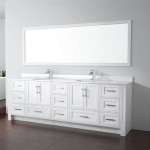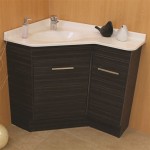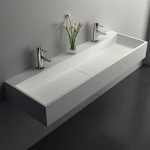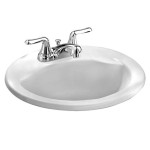Moen Bathroom Sink Faucet Repair Instructions
Moen bathroom sink faucets are known for their durability and style, routinely found in residential and commercial settings. However, like all mechanical devices that are subject to constant usage, wear and tear can eventually take its toll. Common issues include leaks, reduced water flow, and difficulties with handle operation. This article provides comprehensive repair instructions for various Moen bathroom sink faucet problems, guiding the user through the necessary steps to diagnose the issue and perform the correct repair.
Before embarking on any repairs, it is crucial to prioritize safety. The initial step involves turning off the water supply to the faucet. This can typically be accomplished by locating the shut-off valves underneath the sink. Turn both the hot and cold water valves clockwise until they are fully closed. If shut-off valves are not present, the main water supply to the property must be turned off. This is usually located in the basement or near the water meter. After shutting off the water supply, open the faucet to relieve any remaining water pressure. Also, covering the sink drain is helpful to prevent small parts from falling into it and going down the drain.
Gathering the necessary tools is essential for a smooth and efficient repair process. Common tools required for Moen faucet repairs include: adjustable wrench, screwdrivers (both Phillips head and flathead), pliers, Allen wrenches (various sizes), plumber's grease, white vinegar, clean cloths or sponges, and a faucet cartridge puller (optional, but often helpful). Having these tools readily available will minimize interruptions and ensure the successful completion of the repair.
Identifying the Leak Source
Leaks are a prevalent problem with bathroom sink faucets. Before attempting any repairs, accurately identifying the source of the leak is critical. Leaks can originate from several areas, including the base of the faucet, the spout, the handle, or the drain assembly. Observing the leak carefully will help pinpoint the specific location and determine the required repair. Examine the areas around the faucet base where it meets the sink. Inspect the spout for drips or signs of water accumulation. Check the handle area for leaks when the faucet is in both the on and off positions. Finally, inspect the drain assembly underneath the sink for any signs of leaks around the connections or the drain body.
Once the leak source is identified, a further assessment is necessary. For example, a leak at the base of the faucet might indicate a worn-out O-ring or a loose connection. A leak from the spout could suggest a faulty cartridge or aerator. A leak around the handle often points to a worn cartridge or handle O-ring. A leak in the drain assembly typically requires tightening the connections or replacing the washers or seals.
After isolating the leak to a specific section, turn your attention to the parts within that section. For example, if the leak is coming from the faucet handle, the cartridge is likely the culprit. Likewise, a leak on the drain assembly suggests faulty washers or seals. This step is crucial in making sure that there is an accurate diagnosis before disassembling any components.
Replacing a Moen Faucet Cartridge
The cartridge is a critical component within a Moen faucet, responsible for controlling water flow and temperature. Over time, mineral deposits and wear can cause the cartridge to malfunction, leading to leaks or difficulty controlling the water. Replacing the cartridge is a common repair procedure for Moen faucets.
The first step in replacing the cartridge is to remove the faucet handle. The handle is typically secured by a set screw, which is usually located on the side or underneath the handle. Use an Allen wrench to loosen the set screw and then gently pull the handle off the faucet body. Some handles may require unscrewing a decorative cap to access the set screw.
With the handle removed, the cartridge retaining clip or nut will be visible. This clip or nut secures the cartridge in place within the faucet body. Use pliers or an adjustable wrench to remove the clip or loosen the nut. Be careful not to damage the surrounding components during this step. If a retaining clip is present, carefully pry it out using a small screwdriver or pliers.
Once the retaining clip or nut is removed, the old cartridge can be extracted from the faucet body. This may require some force, especially if the cartridge has been in place for a long time. A faucet cartridge puller can be a helpful tool for this step. If a cartridge puller is not available, try gently wiggling the cartridge back and forth while pulling upwards. Avoid using excessive force, which could damage the faucet body.
Before installing the new cartridge, clean the inside of the faucet body to remove any debris or mineral deposits. Apply a thin layer of plumber's grease to the O-rings on the new cartridge. This will help create a watertight seal and make it easier to install the cartridge.
Insert the new cartridge into the faucet body, ensuring that it is properly aligned. The cartridge should fit snugly and securely. Replace the retaining clip or nut to secure the cartridge in place. Tighten the nut or clip securely, but avoid over-tightening, which could damage the cartridge or faucet body.
Finally, reattach the faucet handle and tighten the set screw. Turn the water supply back on and test the faucet to ensure that the leak is resolved and that the water flow and temperature are properly controlled.
Addressing Low Water Flow
Reduced water flow in a Moen bathroom sink faucet can be frustrating. Common causes include a clogged aerator, debris in the cartridge, or issues with the water supply lines. Addressing low water flow requires a systematic approach to identify and resolve the underlying problem.
The first thing to check when experiencing low water flow is the aerator. The aerator is located at the tip of the faucet spout and is responsible for mixing air into the water stream. Over time, mineral deposits and debris can accumulate in the aerator, restricting water flow. Unscrew the aerator from the spout using pliers or an adjustable wrench. Rinse the aerator under running water to remove any loose debris. If necessary, soak the aerator in white vinegar for several hours to dissolve mineral deposits. Reassemble the aerator and test the water flow.
If cleaning the aerator does not resolve the low water flow, the next step is to inspect the cartridge. As previously mentioned, debris can accumulate in the cartridge, restricting water flow. Follow the steps outlined in the "Replacing a Moen Faucet Cartridge" section to remove the cartridge. Once the cartridge is removed, inspect it for any signs of debris or mineral deposits. Clean the cartridge thoroughly and reinstall it. Test the water flow to see if the problem is resolved.
If the aerator and cartridge are clean, the issue may lie with the water supply lines. Check the shut-off valves under the sink to ensure that they are fully open. If the valves are partially closed, open them completely to maximize water flow. Inspect the supply lines for any kinks or bends that could be restricting water flow. Straighten any kinks or replace damaged supply lines. In older homes, the supply lines themselves might be corroded internally restricting flow even if unobstructed externally; replacement of the supply lines might be needed in such cases.
In some cases, low water pressure throughout the property can contribute to reduced water flow in the faucet. If the water pressure is consistently low in other fixtures as well, it may be necessary to contact a plumber to investigate the issue further. A plumber can check the water pressure at the main supply line and identify any problems with the plumbing system.
Following these troubleshooting steps will help to diagnose and resolve most low water flow issues in Moen bathroom sink faucets. Start with the simplest solutions, such as cleaning the aerator, and then move on to more complex repairs, such as inspecting the cartridge and supply lines. With a systematic approach, it is often possible to restore proper water flow to the faucet.

How To Fix A Dripping Moen Faucet Howtolou Com

Moen Bathroom Faucet Repair 1225

Leaky Moen Kitchen Faucet Repair

Tighten A Loose Lever On Moen Brantford Faucet

Moen T4572p Bathroom Faucet Ereplacementparts Com

Tighten A Loose Lever On Moen Brantford Faucet

Moen Single Handle Kitchen Faucet Troubleshooting Repair Guide Arcora Faucets

How To Fix Moen Single Handle Faucets

Moen T6620bn Instruction Manual

How To Fix Moen Single Handle Faucets
Related Posts







